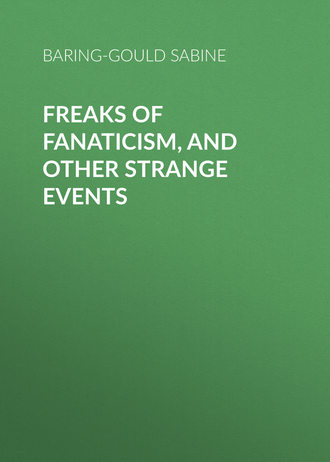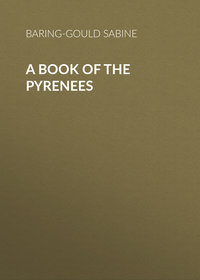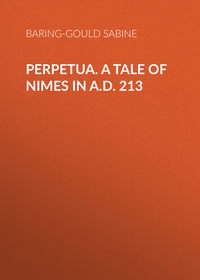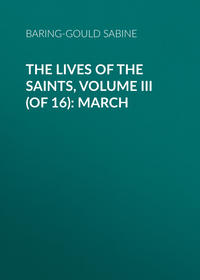 полная версия
полная версияFreaks of Fanaticism, and Other Strange Events
Thereupon Elizabeth exclaimed, "I will gladly die for the saving of the souls of my brother and father. Strike me dead, strike me dead!" Then she threw herself on the bed and began to batter her head with a wooden mallet.
"It has been revealed to me," said Margaret, "that Elizabeth will sacrifice herself." Then taking up the iron hammer, she struck her sister on the head. At once a spiritual fury seized on all the elect souls, and seizing weapons they began to beat the poor girl to death. Margaret in her mania struck at random about her, and wounded both John Moser and Ursula Kündig. Then she suddenly caught the latter by the wrist and bade her kill Elizabeth with the iron wedge. Ursula shrank back, "I cannot! I love her too dearly!" "You must," screamed the saint; "it is ordained." "I am ready to die" moaned Elizabeth. "I cannot! I cannot!" cried Ursula. "You must," shouted Margaret. "I will raise my sister again, and I also will rise again after three days. May God strengthen your arm."
As though a demoniacal influence flowed out of the holy maid, and maddened those about her, all were again seized with frenzy. John Moser snatched the hammer out of her hand, and smote the prostrate girl with it again, and yet again, on head and bosom and shoulders. Susanna brought down a crow-bar across her body, the servant-man Heinrich belaboured her with a fragment of the floor planking, and Ursula, swept away by the current, beat in her skull with the wedge. Throughout the turmoil, the holy maid yelled: "God strengthen your arms! Ursula, strike home! Die for Christ, Elizabeth!" The last words heard from the martyred girl were an exclamation of resignation to the will of God, as expressed by her sister.
One would have supposed that when the life was thus battered out of the unfortunate victim, the murderers would have come to their senses and been filled with terror and remorse. But it was not so. Margaret sat beside the body of her murdered sister, the blaze of spiritual ecstasy in her eyes, the blood-stained hammer in her right hand, terrible in her inflexible determination, and in the demoniacal energy which was to possess her to the last breath she drew. Her bosom heaved, her body quivered, but her voice was firm and her tone authoritative, as she said, "More blood must flow. I have pledged myself for the saving of many souls. I must die now. You must crucify me." John Moser and Ursula, shivering with horror, entreated, "O do not demand that of us." She replied, "It is better that I should die than that thousands of souls should perish."
So saying she struck herself with the hammer on the left temple. Then she held out the weapon to John Moser, and ordered him and Ursula to batter her with it. Both hesitated for a moment.
"What!" cried Margaret turning to her favourite disciple, "will you not do this? Strike and may God brace your arm!" Moser and Ursula now struck her with the hammer, but not so as to stun her.
"And now," said she with raised voice, "crucify me! You, Ursula, must do the deed."
"I cannot! I cannot!" sobbed the wretched girl.
"What! will you withdraw your hand from the work of God, now the hour approaches? You will be responsible for all the souls that will be lost, unless you fulfil what I have appointed you to do."
"But O! not I – !" pleaded Ursula.
"Yes – you. If the police authorities had executed me, it would not have fallen to you to do this, but now it is for you to accomplish the work. Go, Susan, and fetch nails, and the rest of you make ready the cross."
In the meantime, Heinrich, the man-servant, frightened at what had taken place, and not wishing to have anything more to do with the horrible scene in the upper chamber, had gone quietly down into the wood-house, and was making stakes for the vines. There Susanna found him, and asked him for nails, telling him for what they were designed. He composedly picked her out nails of suitable length, and then resumed his work of making vine stakes. Susanna re-ascended to the upper room, and found Margaret extended on the bed beside the body of Elizabeth, with the arms, breast, and feet resting on blocks of wood, arranged, whilst Susanna was absent, by John Moser and Ursula, under her in the fashion of a cross.
Then began the horrible act of crucifixion, which is only conceivable as an outburst of religious mania, depriving all who took part in it of every feeling of humanity, and degrading them to the level of beasts of prey. At the subsequent trial, both Ursula and John Moser described their condition as one of spiritual intoxication.
The hands and feet of the victim were nailed to the blocks of wood. Then Ursula's head swam, and she drew back. Again Margaret called her to continue her horrible work. "Go on! go on! God strengthen your arm. I will raise Elizabeth from the dead, and rise myself in three days." Nails were driven through both elbows and also through the breasts of Margaret; not for one moment did the victim express pain, nor did her courage fail her. No Indian at the stake endured the cruel ingenuity of his tormentors with more stoicism than did this young woman bear the martyrdom she had invoked for herself. She impressed her murderers with the idea that she was endowed with supernatural strength. It could not be otherwise, for what she endured was beyond the measure of human strength. That in the place of human endurance she was possessed with the Berserker strength of the furor religiosus, was what these ignorant peasants could not possibly know. Conrad Moser could barely support himself from fainting, sick and horror-struck at the scene. He exclaimed, "Is not this enough?" His brother, John, standing at the foot of the bed, looked into space with glassy eyes. Ursula, bathed in tears, was bowed over the victim. Magdalena Moser had taken no active part in the crucifixion; she remained the whole time, weeping, leaning against a chest.
The dying woman smiled. "I feel no pain. Be yourselves strong," she whispered. "Now, drive a nail or a knife through my heart."
Ursula endeavoured to do as bidden, but her hand shook and the knife was bent. "Beat in my skull!" this was the last word spoken by Margaret. In their madness Conrad Moser and Ursula Kündig obeyed, one with the crowbar, the other with the hammer.
It was noon when the sacrifice was accomplished – dinner-time. Accordingly, all descended to the sitting-room, where the meal that Margaret Jäggli had been in the meantime preparing was served and eaten.
They had scarce finished before a policeman entered with a paper for old Peter to sign, in which he made himself answerable to produce his daughters before the magistrates when and where required. He signed it with composure, "I declare that I will cause my daughters, if in good health, to appear before the Upper Amtsmann in Andelfingen when so required." Then the policeman departed without a suspicion that the two girls were lying dead in the room above. On Sunday the 16th, the servant Heinrich was sent on horseback to Illnau to summon Jacob Morf to come to Wildisbuch and witness a great miracle. Jacob came there with Heinrich, but was not told the circumstances of the crucifixion till he reached the house. When he heard what had happened, he was frightened almost out of his few wits, and when taken upstairs to see the bodies, he fainted away. Nothing – no representations would induce him to remain for the miraculous resurrection, and he hastened back to Illnau, where he took to his bed. In his alarm and horror he sent for the pastor, and told him what he had seen.
But the rest of the holy community remained stead-fast in their faith. On the night of Sunday before Monday morning broke, Ursula Kündig and the servant man Heinrich went upstairs with pincers and drew out the nails that transfixed Margaretta. When asked their reason for so doing, at the subsequent trial, they said that they supposed this would facilitate Margaretta's resurrection. Sanctus furor had made way for sancta simplicitas.
The night of Monday to Tuesday was spent in prayer and Scripture-reading in the upper chamber, and eager expectation of the promised miracle, which never took place. The catastrophe could no longer be concealed. Something must be done. On Tuesday, old John Peter pulled on his jacket and walked to Trüllikon to inform the pastor that his daughter Elizabeth had died on the Saturday at 10 a.m., and his daughter Margaretta at noon of the same day.
We need say little more. On Dec. 3rd, 1823, the trial of all incriminated in this frightful tragedy took place at Zürich and sentence was pronounced on the following day. Ursula Kündig was sentenced to sixteen years' imprisonment, Conrad Moser and John Peter to eight years, Susanna Peter and John Moser to six years, Heinrich Ernst to four years, Jacob Morf to three, Margaret Jäggli to two years, Barbara Baumann and Casper Peter to one year, and Magdalena Moser to six months with hard labour. The house at Wildisbuch was ordered to be levelled with the dust, the plough drawn over the foundation, and that no house should again be erected on the spot.
Before the destruction, however, a pilgrimage of Pietists and believers in Margaret Peter had visited the scene of her death, and many had been the exclamations of admiration at her conduct. "Oh, that it had been I who had died!" "Oh, how many souls must she have delivered!" and the like. Magna est stultitia et prævalebit.
At a time like the present, when there is a wave of warm, mystic fever sweeping over the country, and carrying away with it thousands of ignorant and impetuous souls, it is well that the story – repulsive though it be – should be brought into notice, as a warning of what this spiritual excitement may lead to – not, indeed, again, maybe, into bloodshed. It is far more likely to lead to, as it has persistently, in every similar outbreak, into moral disorders, the record of which, in the case of Margaretta Peter, we have passed over almost without a word.
Authority: Die Gekreuzigte von Wildisbuch, von J. Scherr, 2nd Edit., St. Gall. 1867. Scherr visited the spot, collected information from eye-witnesses, and made copious extracts from the records of the trial in the Zürich archives, where they are contained in Vol. 166, folio 1044, under the heading: "Akten betreffened die Gräuel – Scenen in Wildisbuch."
A Northern Raphael
Here and there in the galleries of North Germany and Russia may be seen paintings of delicacy and purity, delicacy of colour and purity of design, the author of which was Gerhard von Kügelgen. The majority of his paintings are in private hands; but an Apollo, holding the dying Hyacinthus in his arms, is in the possession of the German Emperor; Moses on Horeb is in the gallery of the Academy of Fine Arts at Dresden; a St. Cæcilia and an Adonis, painted in 1794 and 1795, were purchased by the Earl of Bristol; a Holy Family is in the Gallery at Cassel; and some of the sacred subjects have found their way into churches.
In 1772, the wife of Franz Kügelgen, a merchant of Bacharach on the Rhine, presented her husband with twin sons, the elder of whom by fifteen minutes is the subject of this notice. His brother was named Karl. Their resemblance was so great that even their mother found a difficulty in their early childhood in distinguishing one from the other.
Bacharach was in the Electorate of Cologne, and when the Archbishop-Elector, Maximilian Franz, learned that the twins were fond of art, in 1791 he very liberally gave them a handsome sum of money to enable them to visit Rome and there prosecute their studies.
Gerhard was at once fascinated by the statuary in the Vatican, and by the pictures of Raphael. The ambition of his life thenceforward was to combine the beauty of modelling of the human form that he saw in the Græco-Roman statues with the beauty of colour that he recognised in Raphael's canvases. Karl, on the other hand, devoted himself to landscapes.
In 1795 the brothers separated, Gerhard that he might visit Munich. Thence, in the autumn, he went to Riga with a friend, and there he remained rather over two years, and painted and disposed of some fifty-four pictures. Then he painted in St. Petersburg and Revel, and finally settled into married life and regular work at Dresden in 1806. There he became a general favourite, not only on account of his artistic genius, but also because of the fascination of his modest and genial manner. He was honoured by the Court, and respected by everyone for his virtues. Orders flowed in on him, and his paintings commanded good prices. The king of Saxony ennobled him, that is to say, raised him out of the bürger-stand, by giving him the privilege of writing a Von before his patronymic.
Having received an order from Riga for a large altar picture, he bought a vineyard on the banks of the Elbe, commanding a charming prospect of the river and the distant blue Bohemian mountains. Here he resolved to erect a country house for the summer, with a large studio lighted from the north. The construction of this residence was to him a great pleasure and occupation. In November, 1819, he wrote to his brother, "My house shall be to us a veritable fairy palace, in which to dwell till the time comes, when through a little, narrow and dark door we pass through into that great habitation of the Heavenly Father in which are many mansions, and where our whole family will be re-united. Should it please God to call me away, then Lily (his wife) will find this an agreeable dower-house, in which she can supervise the education of the children, as the distance from the town is only an hour's walk."
The words were written, perhaps, without much thought, but they foreshadowed a terrible catastrophe. Kügelgen would pass, before his fairy palace was ready to receive him, through that little, narrow door into the heavenly mansions.
The holy week of 1820 found him in a condition of singularly deep religious emotion. He was a Catholic, but had, nevertheless, allowed his son to be confirmed by a Protestant pastor. The ceremony had greatly affected him, and he said to a friend, who was struck at the intensity of his feeling, "I know I shall never be as happy again till I reach Heaven."
On March 27th, on the very day of the confirmation, he went in the afternoon a walk by himself to his vineyard, to look at his buildings. He invited one of his pupils to accompany him, but the young man had some engagement and declined.
At 5 p.m. he was at the new house, where he paid the workmen, gave some instructions, and pointed out where he would do some planting, so as to enchance the picturesqueness of the spot. At some time between six and seven he left, to walk back to Dresden, along the road from Bautzen.
Every one who has been at the Saxon capital knows that road. The right bank of the Elbe above Dresden rises in picturesque heights covered with gardens and vineyards, from the river, and about a mile from the bridge is the Linkes Bad, with its pleasant gardens, theatre, music and baths. That road is one of the most charming, and, therefore, the most frequented outside the capital. On the evening in question the Easter moon was shining.
Kügelgen did not return home. His wife sent his son, the just confirmed boy, aged 17 years, to the new house, to inquire for her husband. The boy learned there that he had left some hours before. He returned home, and found that still his father had not come in. The police were communicated with, and the night was spent in inquiries and search, but all in vain. On the following morning, at 9 a.m., as the boy was traversing the same road, along with a gensdarme, he deemed it well to explore a footpath beside the river, which was overflown by the Elbe, and there, finally, amongst some reeds they discovered the dead body of the artist, stripped of his clothes to his shirt and drawers, lying on his face.
Gerhard von Kügelgen had been murdered. His features were cut and bruised, his left temple and jaw were broken. Footsteps, as of two persons, were traceable through the river mud and across a field to the highway. Apparently the artist had been murdered on the road, then carried or dragged to the path, stripped there, and then cast among the rushes. About twenty-four paces from where he lay, between him and the highway, his cap was found.
The excitement, the alarm, aroused in Dresden was immense. Not only was Kügelgen universally respected, but everyone was in dismay at the thought that his own safety was jeopardised, if a murder such as this could be perpetrated on the open road, within a few paces of the gates. Indeed, the place where the crime was committed was but a hundred strides from the Linkes Bad, one of the most popular resorts of the Dresdeners.
It was now remembered that only a few months before, near the same spot, another murder had been committed, that had remained undiscovered. In that case the victim had been a poor carpenter's apprentice.
On the same day as the body of Kügelgen was found, the Government offered a sum equal to £150 for the discovery of the murderer. A little later, some children found among the rubbish, outside the Black Gate of the Dresdener Vorstadt, a blue cloth cloak, folded up and buried under some stones. It was recognised as having belonged to Kügelgen. Moreover, in the pocket was the little "Thomas-à-Kempis" he always carried about with him.
It was concluded that the murderer had not ventured to bring all the clothing of Kügelgen into the town, through the gate, and had, therefore, hidden portions in places whence he could remove them one by one, unobserved. The murderer was, undoubtedly, an inhabitant of the city.
From March 29th to April 4th the police remained without any clue, although a description of the garments worn by the murdered man, and of his watch, was posted up at every corner, and sent round to the nearest towns and villages.
The workmen who had been engaged on Kügelgen's house were brought before the police. They had left after his departure, and had received money from him; but they were discharged, as there was no evidence against them.
As no light seemed to fall on this mysterious case, the police looked up the circumstances of the previous murder. On December 29th, 1819, a carrier on the highroad had found a body on the way. It was ascertained to be that of a carpenter's apprentice, named Winter. His skull had been broken in. Not a trace of the murderer was found; not even footprints had been observed. However, it was learned that the wife of a labourer had been attacked almost at the same spot, on the 28th December, by a man wearing a military cap and cloak; and she had only escaped him by the approach of a carriage, the sound of the wheels having alarmed him, and induced him to fly. He had fled in the direction of the Black Gate and the barracks.
The anxiety of the Dresdeners seemed justified. There was some murderous ruffian inhabiting the Vorstadt, who hovered about the gates, waylaying, not wealthy men only, but poor charwomen and apprentices.
The military cloak and cap, the direction taken by the assailant in his flight, gave a sort of clue – and the police suspected that the murderer must be sought among the soldiers.
On April 4th two Jewish pawnbrokers appeared before the police, and handed over a silver watch which had been left with them at 9 a.m. on the 20th March – that is to say on the morning after the murder of Kügelgen – and which agreed with the advertised description of the artist's lost watch. It was identified at once. The man who had pawned it, the Jews said, wore the uniform of an artillery soldier.
At the request of the civil authorities, the military officers held an inquisition in the barracks. All the artillery soldiers were made to pass before the Jew brokers, but they were unable to identify the man who had deposited the watch with them. Somewhat later in the day one of these Jews, as he was going through the street, saw a man in civil dress, whom he thought he recognised as the fellow who had given him the watch. He went up to him at once and spoke about the watch. The man at first acknowledged that he had pawned one, then denied, and threatened the Jew when he persevered in clinging to him. A gendarme came up, and hearing what the controversy was about, arrested the man, who gave his name as Fischer, a gunner.
Fischer was at once examined, and he doggedly refused to allow that he had given up a watch to the Jew.
Suspicion against him was deepened by his declaring that he had heard nothing of the murder – a matter of general talk in Dresden – and that he had not seen the notices with the offer of reward for the discovery of the murderer. On the following day, April 5th, however, he admitted having pawned the watch, which he pretended to have found outside the Black Gate. A few hours later he withdrew this confession, saying that he was so bewildered with the questions put to him, and so alarmed at his arrest, that he did not well know what he said. It was observed that Fischer was a man of very low intellectual power.
The same day he was invested in his uniform, and presented before the pawnbrokers. Both unanimously declared that he was not the man who had entered their shop and deposited the watch with them. They both declared that though Fischer had the same height and general build as the man in question, and the same fair hair, yet that the face was different.
With this, the case against Fischer broke down; nevertheless, though he had been handed over by the military authorities to the civil power, he remained under arrest. The public was convinced of his guilt, and the police hoped by keeping him in prison to draw from him later some information which might prove serviceable.
And, in fact, after he had been a fortnight under arrest, he volunteered a statement. He was conducted at once before the magistrate, and confessed that he had murdered Von Kügelgen. He, however, stoutly denied having laid hands on the carpenter Winter. Nevertheless, on the way back to his cell he told his gaoler that he had committed this murder as well. Next day he was again brought before the magistrate, and confessed to both murders. He was taken to the spots where the two corpses had been found, and there he renewed his confession, though without entering into any details.
But on the next morning, April 21, he begged to be again heard, and he then asserted that his former confessions were false. He had confessed merely because he was weary of his imprisonment and the poor food he was given, and decided to die. When spoken to by the magistrates seriously, and remonstrated with for his contradictions, he cried out that he was innocent. Let them torture him as much as they pleased, he wished to die.
But hardly was he back in his prison than he told the gaoler that it was true that he was the murderer of both Kügelgen and Winter. Again he confessed before the magistrate, and again, on the 27th, withdrew his confession and protested his innocence.
On the 21st April a new element in the case came to light, that perplexed the question not a little.
A Jewish pawnbroker, Löbel Graff, announced that on February 3, 1820, he had received from the gunner Kaltofen, a green coat, and on the 4th April a dark-blue cloth coat, stained with spots of oil, also a pair of cloth trousers. As both coats seemed to him suspicious, and to resemble those described in the advertisements, he had questioned Kaltofen about them, but had received equivocal answers, and Kaltofen at last admitted that he had bought them from the gunner Fischer.
John Gottfried Kaltofen was a young man of 24 years, servant to one of the officers, and therefore did not live in the barracks. He was now taken up. His manner and appearance were in his favour. He was frank, and at once admitted that he had disposed of the two coats to Graff, and that he had bought them of Fischer. On confrontation with the latter he repeated what he had said. Fischer fell into confusion, denied all knowledge of Kaltofen, protested his innocence, and denied the sale of the coats, one of which had in the meantime been identified as having belonged to Winter, and the other to Kügelgen.
On April 27th a search was made in the lodgings of Kaltofen, and three keys were found there, hidden away, and these proved to have belonged to Kügelgen. At first Kaltofen declared that he knew nothing of these keys, but afterwards said that he remembered on consideration that he had found them in the pocket of the blue coat he had purchased from Fischer, and had put them away before disposing of the coat, and had given them no further thought. Not many minutes after Fischer had been sent back to prison, he begged to be brought before the magistrate again, and now admitted that it was quite true that he had sold both coats to Kaltofen.











